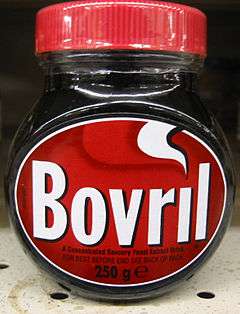John Lawson Johnston

Johnston as caricatured by Spy (Leslie Ward) in Vanity Fair, February 1897

John Lawson Johnston (1839– 24 November 1900) was the creator of Bovril. He was born in 29 Main Street, Roslin, Midlothian. A memorial plaque is on the property and can be seen above the door. The plaque was put there by the Roslin Heritage Society.
Life and "Bovril"
Johnston studied in Edinburgh at some point and came into contact with Lyon Playfair, a professor of chemistry at the University of Edinburgh. Through him, John developed an interest in food science and preserving.[1]
Regardless of what his intentions had originally been as a choice of profession, Johnston's uncle John was a butcher and his nephew decided to pursue this as a trade and apprenticed with him.[1] Eventually, he took over his butcher shop in Edinburgh and became well established.[1] While working as a butcher in Edinburgh, he decided to use the large quantity of beef trimmings produced in the butchery process to make his own glace de viande (meat glaze) – beef stock, concentrated by heating until it becomes dark brown and viscous, thus giving it a long shelf-life.[1] This sold so well that he opened a second shop and a factory in the Holyrood area.[2]
In 1871, he emigrated to Canada and set up business in that country. In 1874, the French Army gave him a contract to supply the army with preserved beef products, Britain not having enough beef to supply the French demand in the Franco-Prussian War.[1] While there, he developed Johnston's Fluid Beef (brand Bovril).[3] This was somewhat different from conventional meat glaze in that the gelatin, present in all meat glaze and making it solid at room temperature, was hydrolysed with alkali to make the mixture semi-liquid, and thereby easier to package, measure and use. [1] For his services, he was awarded the Order of the French Red Cross.[4]
He sold his Canadian business in 1880, after his factory burned down, [2] and went to England where he lived at 'Bovril Castle' – Kingswood House, Sydenham – while he developed the Bovril brand across Britain, based on the commercial promotion of dietetics. When he sold the Bovril company in 1896 he earned £2 million,[5] although he stayed on as Chairman until his death in 1900.
He was a keen yachtsman and died aboard his yacht White Ladye in Cannes, France, on November 24, 1900.[6] [7] His body was brought back to England and interred in a large mausoleum in West Norwood Cemetery.
His second son George Lawson Johnston also managed the Bovril company and was raised to the peerage as Baron Luke.
References
- 1 2 3 4 5 6 The City of Edinburgh Council Archives
- 1 2 "Taking stock of Bovril" (9 June 2010) The Scottish Sun
- ↑ "Statutes of the Province of Quebec, An Act to incorporate "The Canadian Meat and Produce Company." [Assented to 23rd February, 1875.]
- ↑ Guy's Hospital Gazette, Volume 14 (1900) London
- ↑ "BOVRIL.". Morning Bulletin (Rockhampton, Qld. : 1878 – 1954). Rockhampton, Qld.: National Library of Australia. 16 January 1901. p. 6. Retrieved 29 December 2013.
- ↑ The Annual register of world events: a review of the year, Volume 142 (1901) Longman's, Green & Co., London
- ↑ "Inventor of "Bovril" Dead". The New York Times. 25 November 1900. Retrieved 18 January 2013.